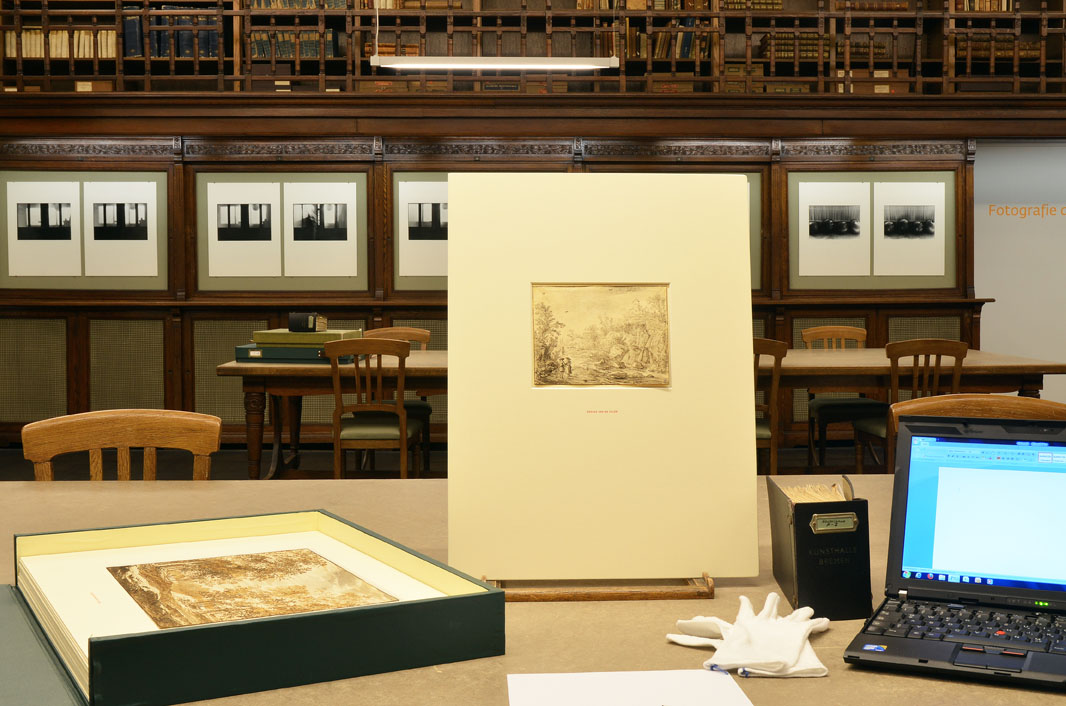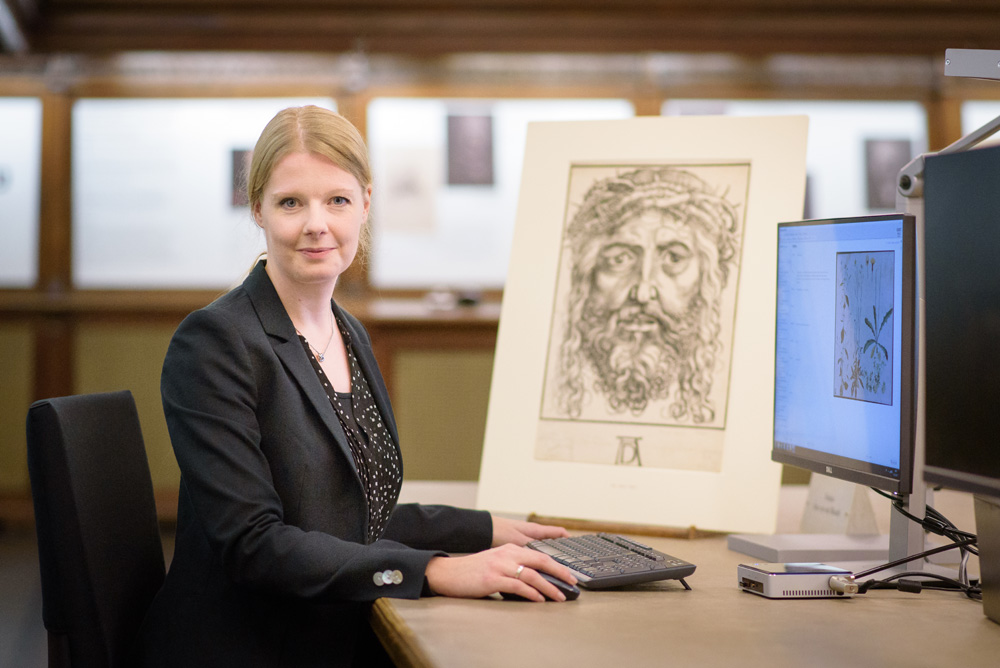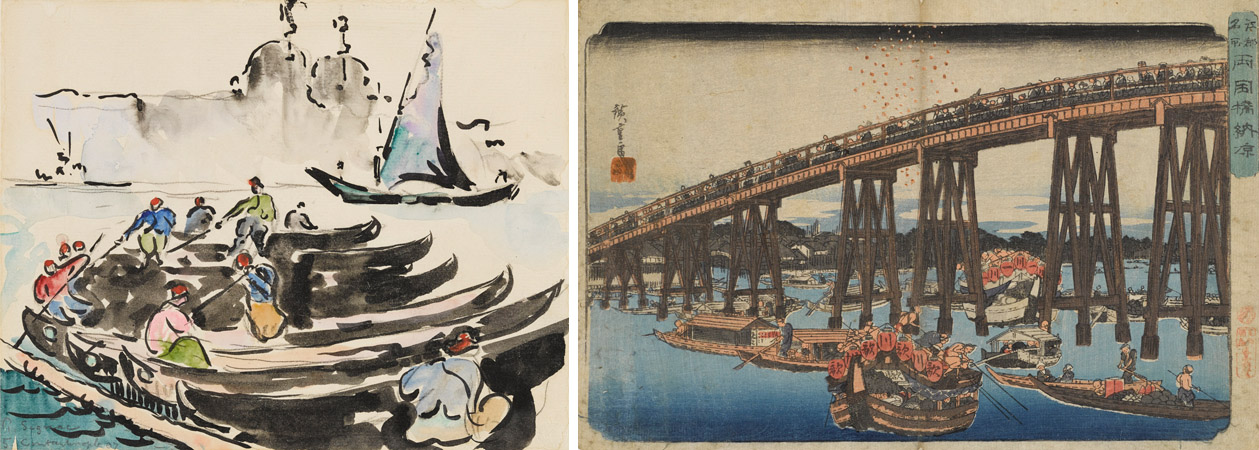Making the Department of Prints and Drawings accessible digitally
In 2014, the Kunsthalle Bremen began a comprehensive project to make the entire holdings of the Department of Prints and Drawings accessibly digitally (over 200,000 drawings and prints).

Digitalization at the Department of Prints and Drawings (photo: Karen Blindow)
The works on paper from the fifteenth to the twenty-first centuries will be incorporated into the Kunsthalle’s existing, public online database and released successively. Digitalizing these masterpieces will allow the broader public to view them and provide access to international academic researchers. The plan is to integrate the holdings into the Graphikportal, the Deutsche Digitale Bibliothek, and Europeana to allow national and international access to various collections.
As part of the digitalization projects, a digital photograph of the artwork is taken. Technical information such as the artist’s name, title of the work, measurements, and techniques used, along with old and new inscriptions plus the provenance with dates of purchase and previous owners is recorded as completely as possible. More than half of the works will be systematically documented for the very first time during the course of this project. The information gathered in the database will be augmented by headwords and standard data to optimize them for search functions. This is the basis for later online publication.
Digitalizing the Klugkist Collection
2017 till 2020, we digitized the extensive holdings of German and Netherlandish prints and drawings of the fifteenth and sixteenth centuries from the collection of Hieronymus Klugkist (around 12,000 works on paper). The digitization of the Klugkist Collection was funded by the Federal Ministry of Education and Research.
Bremen senator Hieronymus Klugkist was a founding father of the Kunstverein in Bremen, to whom he bequeathed his art collection and library in 1851. The Klugkist Collection is a cornerstone of the renowned Bremen Department of Prints and Drawings. The project was realized as a part of the digitalization of the Department of Prints and Drawings which began in 2014.

Dr. Nina Janssen oversees the project for digitalizing German and Netherlandish prints from the fifteenth and sixteenth centuries (photo: Melanka Helms)
The more than 12,000 data records created in the course of the project will soon be available in the new online catalogue of the Kunsthalle Bremen. In addition to the complete printed works, the Hieronymus Klugkist bequest from 1851 includes more than 40 drawings and watercolours by Albrecht Dürer and other Old Masters of the German and Netherlandish schools. Klugkist’s many handwritten notes in his books and on the original mats shed light on the Bremen collector’s art connoisseurship. Klugkist was not only an innovator in terms of his interest in landscape motifs, he also purchased numerous drawings. This genre received little appreciation as stand-alone works of art until well into the nineteenth century.
In 2023, the Kunstverein in Bremen will celebrate its 200th anniversary. This will be an occasion to learn more about the important private donors who laid the foundation for today’s holdings and who, in addition to Klugkist, also include Johann Heinrich Albers, Melchior Hermann Segelken, and H.H. Meier Jr.
Digitalizing French and Japanese Graphic Arts
Between May 2019 and April 2023, around 17,000 French and 1,000 Japanese prints and drawings were undergoing the process of digitalization. The Kunsthalle Bremen received funding for the first time from the Deutsche Forschungsgemeinschaft (DFG) for this project.

left: Paul Signac, Boote - Konstantinopel, 1907, Aquarell über schwarzer Kreide | right: Utagawa Hiroshige, Abendstimmung an der Ryôgoku-Brücke, from: Berühmte Orte in Edo, nishiki-e (mehrfarbiger Holzschnitt) | both: Kunsthalle Bremen – Der Kunstverein in Bremen, Department of Prints and Drawings
The collection of French and Japanese art at the Kunsthalle Bremen is of excellent quality and unique in German-speaking countries. Gustav Pauli, Emil Waldmann, and Günter Busch, the three directors between 1899 and 1984, were instrumental in assembling these two collections. Their specialized knowledge and communication with collectors were instrumental in this, along with their deliberate, long-sighted view toward continuity. Making the French holdings accessible together with the Japanese collection stands to reason in light of the phenomenon known as “Japonism” in art history, which was sparked by a close cultural exchange between France and Japan in the second half of the nineteenth century after the opening of Japan. Japanese colour woodcuts influenced Impressionists and Post-Impressionists with their stylistic device of arabesque-like contour lines, the conscious use of emptiness, and the emphasis on two-dimensionality found in the depictions.
The project will provide crucial base data for empirical studies of the collection holdings. Digitalizing key French art inventory promises to reveal important material. In particular, this applies to research into the history of the collection and major private endowments from the time when the Kunstverein was founded (Johann Heinrich Albers Collection and the H.H. Meier Jr Collection), as well as the wartime and post-war periods under directors Waldmann and Busch.
Keyword indexing of prints with the international Iconclass classification system will be undertaken by the Deutsches Dokumentationszentrum für Kunstgeschichte – Bildarchiv Foto Marburg, which, as our project partner, is also responsible for publishing the data on the Graphikportal.
Learn more about the Department of Prints and Drawings here.
Contact us:
Download von Pressebildern mit besonderen Nutzungsbedingungen
Die von Ihnen angefragten Abbildungen unterliegen besonderen Nutzungsbedingungen und dürfen nur zur aktuellen redaktionellen und themengebundenen Berichterstattung unter Angabe der Bildcredits verwendet werden. Die Bilder dürfen nicht beschnitten und es darf kein Text o.ä. über die Bilder gelegt werden. Online dürfen die Bilder nur in einer Auflösung von 72dpi veröffentlicht werden. Die genauen Nutzungsbedingungen werden zusammen mit den Bildern heruntergeladen. Im Falle einer Veröffentlichung erklären Sie sich mit diesen Bedingungen einverstanden.
Für den Download benötigen Sie ein Passwort. Falls Sie noch keine Zugangsdaten besitzen, können Sie diese hier per Mail anfragen.
Vielen Dank für Ihre Anmeldung
Wir haben Ihren Mitgliedsantrag für den Kunstverein in Bremen erhalten. Vielen Dank! Den Mitgliedsausweis/die Mitgliedsausweise senden wir Ihnen innerhalb von 10 Tagen zu.
Ihr Kunstverein in Bremen
OK




